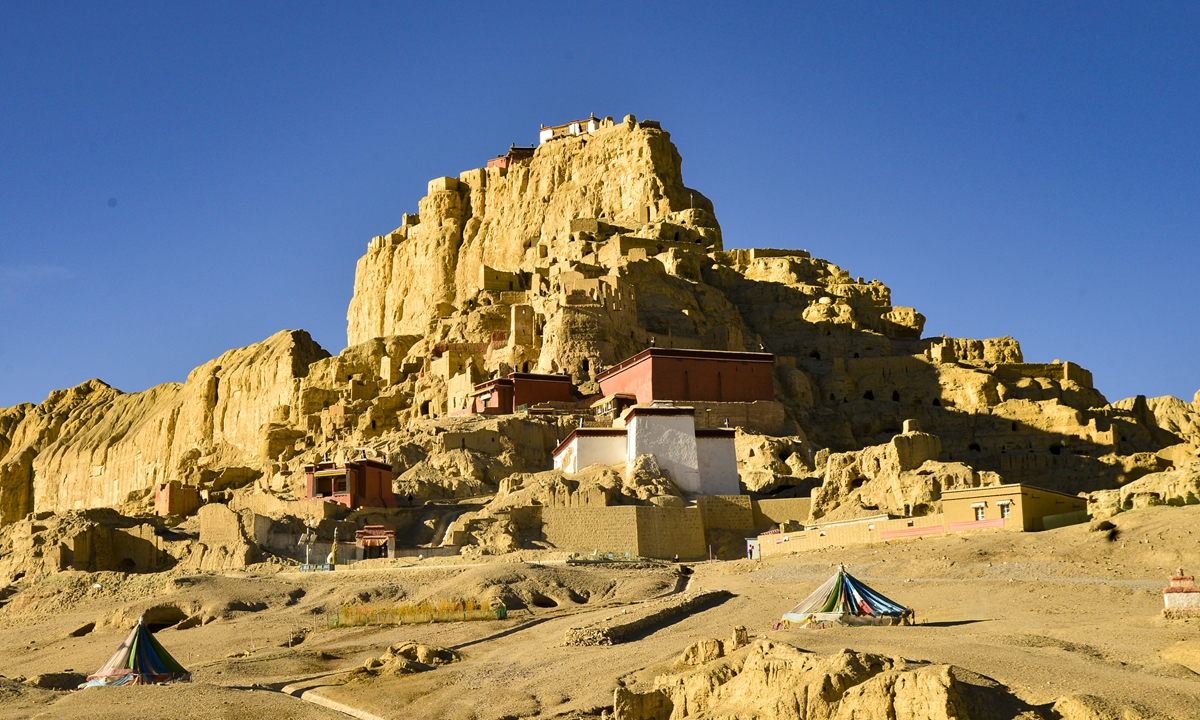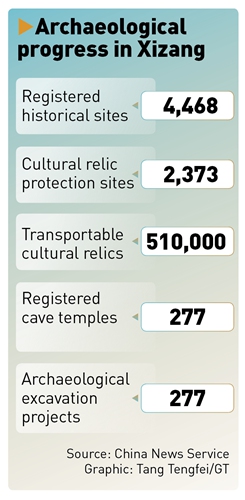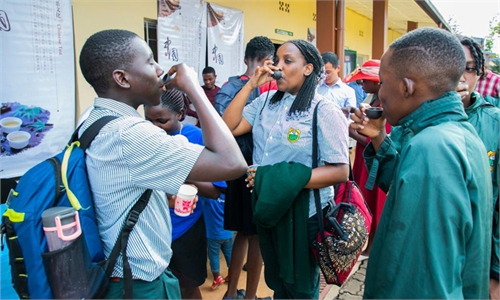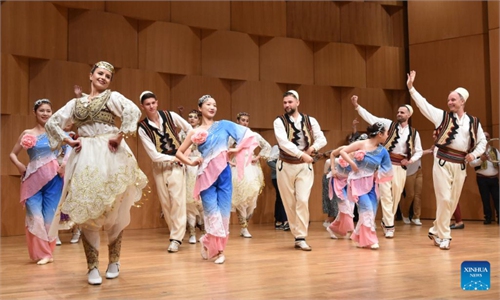ARTS / CULTURE & LEISURE
Xizang Autonomous Region sees progress in cultural relic conservation over past decade
Ancient voices

The Guge Kingdom Ruin Site in Zanda county, Xizang Autonomous Region Photo: VCG
Editor's Note:Over the past decade, enhanced efforts to protect and restore cultural relics in Southwest China's Xizang Autonomous Region have been made thanks to the firm support of the Central Government. More ancient treasures have been excavated and documented, helping complete piecing together regional and national history and make clear the close connection that has existed between the Central Plains and the plateau since ancient times.
In this series about Xizang's cultural relics, the overall situation of conservation work and its achievements will be introduced, while the Potala Palace, one of Xizang's symbols, will be covered as a typical example of protecting and restoring cultural relics through high technology.
The discovery of traces of human activity dating back to more than 4,000 years ago, an archeological investigation into the South Asian corridor of the Silk Road and applications for World Heritage status for historical sites number among the many achievements made in Southwest China's Xizang Autonomous Region over the past decade, officials said on Saturday at a press conference outlining the progress the region has made in the field of cultural relic conservation during the last 10 years.
At the press conference, Xizang officials introduced the progress of cultural relic conservation in various fields, noting that the cultural relics discovered in the region are strong evidence of the fusion of different ethnic groups.
Zhao Xingbang, deputy head of the Cultural Heritage Administration of the Xizang Autonomous Region, explained that the region has registered more than 4,000 historical sites and around 510,000 cultural relics.
A total of 277 archaeological excavations have been carried out in the autonomous region, which has made significant progress in discovering ancient ruin sites and tracing the origins of Chinese civilization.
Authorities in the region have also severely cracked down on and prevented cultural relic related crimes, closing 40 cases and recovering 1,974 cultural relics.
Over this same period, the Central Government has invested a total of 1.71 billion yuan ($241 million) in 131 projects to protect and maintain cultural relics, a record high for financial support.
Xiong Kunxin, a professor at the Minzu University of China in Beijing, told the Global Times that such achievements should be turned into a driving force for promoting future archaeological work in the region.
Stunning discoveries
Carrying out hundreds of archaeological excavation projects in Xizang, Chinese archeologists have found several ruin sites, including human settlements, buildings and tombs, dating back to the Paleolithic period.
More than 500 structures, mainly made of stone and earth, such as fire and ash pits, have been unearthed at the Qiere Site in Xizang's Gar county. Estimates trace the excavated relics and the various stone tools found at the site to the Paleolithic and Neolithic periods.
The site has provided valuable materials for research into the origin and migration routes of ancient people and fills in the gap concerning prehistoric culture on the plateau around 8,000 to 10,000 years ago.
The Mabucuo Site in Kangmar county is a prehistoric settlement site dating back to about 4,000 years. Archaeological evidence of human activities such as fire pits, tombs and relics including pottery and ivory products have been discovered there. The discoveries have led many experts to coin the term "Mabucuo Culture," as the site seems to have been home to a unique lakeside fishing and hunting culture not previously seen on the plateau.
The discovery of human activities in Nwya Devu, a high-altitude archaeological site, was mentioned at the conference. The archaeological team found a large number of stone flakes, stone cores, scrapers and other stone products, demonstrating that ancient humans had set foot on the high altitude area of the Qinghai-Tibet Plateau 30,000 to 40,000 years ago and left clear and solid footprints on the roof of the world.
Firm support
Zhao pointed out that progress in Xizang has benefited from the Central Government's emphasis toward cultural relic conservation and its support in the fields of funding, technology and talent.
With this firm support, Xizang's cultural workers have been able to speed up efforts to digitize Xizang's cultural relics and ancient books as well as establish a database of cultural resources.
"The Central Government supports Xizang in its efforts to conserve its rich cultural resources. Besides local educational institutions such as university research centers, civil organizations and cultural institutions such as museums should also work to promote archaeological work in the region," Xiong noted.
He also noted that introducing such archaeological achievements to the public is important. Public cultural spaces such as museums can help the public "inherit" Xizang's history and culture.
"A large amount of relics show Xizang is forever a part of China. We should let people see them," Xiong remarked.





